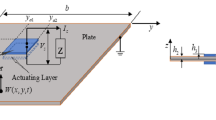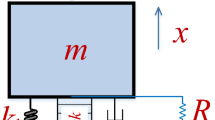Abstract
This paper presents a new acoustic radiation optimization method for a vibrating panel-like structure with a passive piezoelectric shunt damping system in order to minimize well-radiating modes generated from the panel. The optimization method is based on an idea of using the p-version finite element method(p-version FEM), the boundary element method(BEM), and the particle swarm optimization algorithm(PSOA). Optimum embossment design for the vibrating panel using the PSOA is first investigated in order to minimize noise radiation over a frequency range of interest. The optimum embossment design works as a kind of stiffener so that well-radiating natural modes are shifted up with some degrees. The optimized panel, however, may still require additional damping for attenuating the peak acoustic amplitudes. A passive shunt damping system is thus employed to additionally damp the well-radiating modes from the optimized panel. To numerically evaluate the acoustic multiple-mode damping capability by a shunt damping system, the integrated p-version FEM/BEM for the panel with the shunt damping system is modeled and developed by MATLAB. Using the PSOA, the optimization technique for the optimal multiple-mode shunt damper is investigated in order to achieve the optimum damping performance for the well-radiating modes simultaneously. Also, the acoustic damping performance of the shunt damping circuit in the acoustic environment is demonstrated numerically and experimentally with respect to the realistically sized panel. The simulated result shows a good agreement with that of the experimental result.
Similar content being viewed by others
References
S. T. Christensen, S. V. Sorokin and N. Olhoff, On analysis and optimization in structural acousticspart I, Structural Optimization, 16, (1998) 83–95.
M. Tinnsten, P. Carlsson and M. Jonsson, Stochastic optimization of acoustic response — a numerical and experimental comparison, Struct Multidisc Optim. 23, (2002) 405–411.
S. Kaneda, Q. Yu, M. Shiratori and K. Motoyama, Optimization approach for reducing sound power from a vibration plate by its curvature design, JSME Int. J. Series C, 45(1), (2002) 87–98.
M. Ruzzene and A. Baz, Active/passive control of sound radiation and power flow in fluid-loaded shells, Journal of Thin-Walled Structures, 38, (2000) 17–42.
M. A. Simpson, T. M. Luong, C. R. Fuller and J. D. Jones, Full scale demonstration tests of cabin noise reduction using active vibration control, Journal of Aircraft, 30(3), (1992) 624–630.
B. T. Wang, E. K. Dimitriadis and C. R. Fuller, Active control of structurally radiated noise using multiple piezoelectric actuators, AIAA Journal, 29(11), (1990) 1802–1809.
N. W. Hagood and A. H. Von Flotow, Damping of structural vibrations with piezoelectric materials and passive electrical networks, Journal of Sound and Vibration, 146, (1991) 243–268.
C. L. Davis and G. A. Lesieutre, A modal strain-energy approach to the prediction of resistively shunted piezoceramic damping, Journal of Sound and Vibration, 184, (1995) 489–513.
J. J. Hollkamp, Multimodal passive vibration suppression with piezoelectric materials and resonant shunts, J. Intell. Mater. Syst. Struct., 5, (1994) 49–57.
S. Y. Wu, Method for multiple mode shunt damping of structural vibration using a single PZT transducer. Proc. SPIE Smart Structures and Materials, Smart Structures and Intelligent Systems, SPIE 3327, (1998) 159–168.
J. H. Kim, Y. H. Ryu and S. B. Choi, New shunting parameter tuning method for piezoelectric damping based on measured electrical impedance, Smart Mater. Struct., 9, (2000) 868–877.
M. Ahmadian and K. M. Jeric, On the application of shunted piezoceramics for increasing acoustic transmission loss in structures, Journal of Sound and Vibration, 243(2), (2001) 347–359.
D. F. Ostergaard and T. P. Pawlak, Three-dimensional finite elements for analyzing piezoelectric structures, Proceedings of IEEE Ultrason. Symp., (1986) 639–644.
J. Kennedy and R. Eberhart, Particle swarm optimization, Proc. IEEE Int. Conf. On Neural Networks, (1996) 1942–1948.
R. Eberhart and Y. Shi, Comparison between genetic algorithms and particle swarm optimization, 7-th Annual Conf. On Evolutionary Programming, (1998) 611–616.
Author information
Authors and Affiliations
Corresponding author
Additional information
This paper was recommended for publication in revised form by Associate Editor Yeon June Kang
Jin-Young Jeon received his Ph.D. degree in Mechanical and Aerospace Engineering from Tokyo Institute of Technology in 2005. Dr. Jeon is currently a senior engineer at Digital Printing Division, Digital Media & Communications Business at Samsung Elec-tronics Co., Ltd., Korea. His research interests are the areas of structural-acoustic optimization, sound quality, motion quality, and vibration control.
Rights and permissions
About this article
Cite this article
Jeon, JY. Passive acoustic radiation control for a vibrating panel with piezoelectric shunt damping circuit using particle swarm optimization algorithm. J Mech Sci Technol 23, 1446–1455 (2009). https://doi.org/10.1007/s12206-009-0349-9
Received:
Revised:
Accepted:
Published:
Issue Date:
DOI: https://doi.org/10.1007/s12206-009-0349-9




